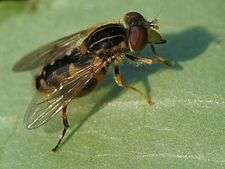Anasimyia lineata
Anasimyia lineata is a Palaearctic species of hoverfly.[1][2][3]
| Anasimyia lineata | |
|---|---|
 | |
| Anasimyia lineata female | |
| Scientific classification | |
| Kingdom: | |
| Phylum: | |
| Class: | |
| Order: | |
| Family: | |
| Genus: | |
| Species: | A. lineata |
| Binomial name | |
| Anasimyia lineata (Fabricius, 1787) | |
Description
External images The face protrudes forwards as a long snout which tapers to a point. The body has dark ground colour. The male has triangular orange markings on the tergites (especially on tergite 2). Female markings are orange or grey. The stigma is in the form of a dark patch between the veins.
Keys and accounts
- Coe R.L. (1953) Syrphidae[4]
- Van Veen, M. (2004) Hoverflies of Northwest Europe [5]
- Van der Goot, V.S. (1981) De zweefvliegen van Noordwest - Europa en Europees Rusland, in het bijzonder van de Benelux[6]
- Bei-Bienko, G.Y. & Steyskal, G.C. (1988) Keys to USSR insects. Diptera[7]
Habits
Wetlands including bog, fen and marsh, pond-side and riverine fen and alluvial wetlands, such as oxbow lakes. Flowers visited include Alisma plantago-aquatica, Caltha, Cardamine pratense, Cicuta viros, Lythrum salicaria, Menyanthes trifoliata, Nymphaea alba, Potentilla anserina, Ranunculus, Lychnis flos-cuculi, Sorbus aucuparia, Crataegus and Anthriscus sylvestris.[8][9] The larva is aquatic and microphagous in rotting plant debris. It is illustrated by Rotheray (1993)[10]
Distribution
Entire temperate Palearctic.[11][12]
References
- Stubbs, Alan E.; Falk, Steven J. (1983). British Hoverflies: An Illustrated Identification Guide (2nd ed.). London: British Entomological and Natural History Society. pp. 253, xvpp. ISBN 1-899935-03-7.
- Ball, S.G.; Morris, R.K.A. (2000). Provisional atlas of British hoverflies (Diptera, Syrphidae). Monks Wood, UK: Biological Record Centre. pp. 167 pages. ISBN 1-870393-54-6.
- Van Veen, M.P. (2004). Hoverflies of Northwest Europe, Identification Keys to the Syrphidae (hardback). Utrecht: KNNV Publishing. p. 254. ISBN 90-5011-199-8.
- Coe, R.L. (1953) Diptera: Syrphidae. Handbks.ident.Br.insects, 10(1): 1-98. R.ent.Soc.London.pdf
- Van Veen, M. (2004) Hoverflies of Northwest Europe: identification keys to the Syrphidae. 256pp. KNNV Publishing, Utrecht.
- Van der Goot, V.S. (1981)De zweefvliegen van Noordwest - Europa en Europees Rusland, in het bijzonder van de Benelux. KNNV, Uitgave no.32: 275pp. Amsterdam.
- Bei-Bienko, G.Y. & Steyskal, G.C. (1988a) Keys to the Insects of the European Part of the USSR, Volume V: Diptera and Siphonaptera, Part I. Amerind Publishing Co., New Delhi. ISBN 81-205-0080-6.
- de Buck, N. (1990) Bloembezoek en bestuivingsecologie van Zweefvliegen (Diptera, Syrphidae) in het bijzonder voor België. Doc.Trav. IRSNB, no.60, 1-167.
- Speight, M.C.D. (2011). "Species accounts of European Syrphidae (Diptera)" (PDF). Syrph the Net, the database of European Syrphidae. 65: 285pp.
- Rotheray G., 1993 Colour Guide to Hoverfly Larvae Diptera, Syrphidae in Britain and Europe Dipterists Forum pdf Archived 2019-04-03 at the Wayback Machine
- Fauna Europaea
- Peck, L.V. (1988) Syrphidae. In: Soos, A. & Papp, L. (eds.) Catalogue of Palaearctic Diptera, 8: 11-230. Akad.Kiado, Budapest.